Administering medication to your feline friend can often feel more like a battle than a bonding experience. If your veterinarian has prescribed tablets for your cat, you’re not alone in facing this common challenge. Many cat owners find the process of giving pills stressful for both themselves and their beloved pets. However, with the right techniques and a calm approach, you can successfully and safely give your cat the medication they need, transforming pill time from a struggle into a manageable routine.
Understanding Your Cat’s Medication Needs
Before you begin, it’s crucial to understand your veterinarian’s instructions. Always clarify whether the medication should be given with food, on an empty stomach, or if there are any specific administration guidelines. This information is vital for the medication’s effectiveness and your cat’s well-being.
Medications for cats come in various forms, including tablets, capsules, and liquids. This guide will primarily focus on How To Administer Tablets To Cats, as this is often cited as the most challenging form for pet owners. Understanding the different methods available can empower you to choose the approach that best suits your cat’s temperament and your comfort level.
Step-by-Step Guide to Administering Tablets to Cats
There are several methods you can employ to give your cat a tablet. We’ll explore a few options, starting with less direct methods and progressing to techniques for manual administration.
Method 1: The Tempting “Treat” Tactic (Use with Caution)
One common initial approach is to try and disguise the pill within a treat. This often involves hiding the tablet in a small piece of your cat’s favorite soft food, such as canned cat food or a pill pocket treat designed for this purpose.
How to try the “Treat” Method:
- Take a small amount of palatable food and create a “meatball” shape.
- Carefully insert the tablet into the center of the food ball, ensuring it’s fully concealed.
- Offer the treat to your cat as enticingly as possible.
Why this often fails:
While seemingly simple, this method frequently backfires with cats. Cats are notoriously discerning eaters and are often adept at detecting hidden pills. They might:
- Eat the food around the pill and spit out the tablet.
- Chew the “meatball,” releasing the pill’s taste and making future attempts harder.
- Become suspicious of treats in general, associating them with unpleasant medication.
If the “treat” method doesn’t work, or if you anticipate your cat being too clever for this trick, it’s best to move on to more direct and reliable methods.
Method 2: Manual Pilling – A Direct Approach
When other methods fail, manual pilling is often the most effective way to ensure your cat receives their medication. While it might seem daunting, following a step-by-step approach can make the process smoother and safer for both you and your cat.
Step-by-Step Manual Pilling Guide:
-
Prepare and Position: Have the tablet ready in your dominant hand, held between your thumb and index finger. Position yourself with your cat facing away from you or sideways, ideally on a stable surface like a table or floor.
-
Secure and Tilt: If you are right-handed, use your left hand to gently but firmly hold your cat’s head from the top. Your fingers can rest on the cheekbones for a secure hold without causing discomfort. Gently tilt your cat’s head upwards towards the ceiling. Often, this tilting motion will naturally cause your cat’s lower jaw to open slightly.
Alt text: Securely holding a cat’s head from above to prepare for oral medication administration.
-
Open the Jaw (If Needed): If your cat doesn’t open their jaw when you tilt their head back, use a finger from your dominant hand (the one holding the pill) to gently open their lower jaw. Place your middle finger over the small incisor teeth in the front of the lower jaw. Crucially, avoid placing your finger over the sharp canine teeth (fangs) to prevent bites.
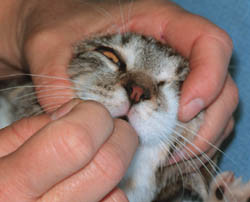 Close-up of fingers opening a cat's lower jaw to give a pill
Close-up of fingers opening a cat's lower jaw to give a pill -
Pill Placement: With the mouth open, quickly and gently place the tablet as far back over the tongue as possible. The further back you place the pill, the more likely your cat is to swallow it reflexively.
-
Encourage Swallowing: Immediately after placing the pill, close your cat’s mouth gently but firmly. You can encourage swallowing by:
- Blowing softly on their nose: This often triggers a natural swallow reflex in cats.
- Gently stroking their throat: A light massage motion downwards along the throat can also encourage swallowing.
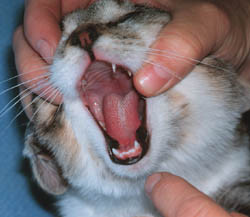 Administering a pill to a cat by dropping it far back on the tongue
Administering a pill to a cat by dropping it far back on the tongue -
Post-Pill Check: After your cat swallows, it’s a good idea to gently offer a small amount of water or a favorite treat to ensure the pill goes down and to create a more positive association with the experience.
Method 3: Utilizing a Pill Dispenser (Piller)
For those who find manual pilling challenging or wish to minimize the risk of bites, a pill dispenser, also known as a piller, can be a valuable tool. This device allows you to place the pill further back in the cat’s mouth without putting your fingers directly inside.
Using a Pill Dispenser:
-
Load the Piller: Place the tablet securely into the tip of the pill dispenser according to the manufacturer’s instructions.
-
Grip and Position: Hold the piller comfortably in your dominant hand. There are various grip styles you can use:
- Thumb and Middle Finger Grip: Hold the device between your thumb and middle finger, using your index finger to push the plunger.
- Curled Finger Grip: Curl your fingers around the device, using your thumb to push the plunger.
- Index and Middle Finger Grip: Hold the device between your index and middle fingers, using your thumb to push the plunger.
Experiment to find the grip that feels most secure and gives you the best control.
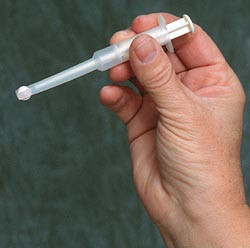 Different grips for holding a pill dispenser for cats
Different grips for holding a pill dispenser for cats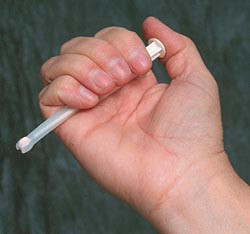 Alternative hand grip for a pill dispenser with thumb trigger
Alternative hand grip for a pill dispenser with thumb trigger Example grip using index and middle fingers on a pill dispenser
Example grip using index and middle fingers on a pill dispenser -
Open Jaw and Insert: Tilt your cat’s head back as in the manual pilling method. If their jaw doesn’t open, use your middle finger (of the hand holding the piller) to gently open their lower jaw, again being mindful of the canine teeth.
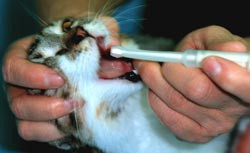 Using a pill dispenser to place medication at the back of a cat's tongue
Using a pill dispenser to place medication at the back of a cat's tongue -
Pill Release: Insert the tip of the piller with the tablet over the base of the tongue and press the plunger to release the pill.
-
Encourage Swallowing: Remove the piller, close your cat’s mouth, and encourage swallowing using the same techniques as in manual pilling (blowing on nose, throat stroking).
Tips for Success and Staying Safe
- Remain Calm: Cats are sensitive to your emotions. A calm and confident demeanor will help keep your cat calmer during the process.
- Gentle Handling: Avoid being forceful. Use firm but gentle movements.
- Recognize Stress Signals: Watch for signs of stress in your cat, such as hissing, growling, flattened ears, or attempts to bite or scratch. If your cat becomes overly stressed, stop and try again later. You may need to break the process into shorter sessions.
- Safety First: Cat bites can be painful and carry bacteria. If bitten, clean the wound thoroughly and seek medical attention if necessary. Consider wearing gloves if your cat is particularly resistant.
What to Do If You’re Still Struggling
If you consistently find it difficult to give your cat tablets, don’t hesitate to consult your veterinarian. They can offer:
- Alternative Medication Forms: Inquire if the medication is available in liquid form or as a flavored chewable treat (if appropriate for the specific medication).
- Compounding Options: Some medications can be compounded into palatable liquids or transdermal gels that are applied to the skin.
- Demonstration and Guidance: Your vet or a veterinary technician can demonstrate pill administration techniques and provide personalized advice for your cat.
Conclusion
Giving your cat tablets may require patience and practice, but mastering these techniques is a valuable skill for any cat owner. By understanding the methods, staying calm, and prioritizing your cat’s comfort and safety, you can successfully administer their medication and contribute to their health and well-being. Remember, consistency and a positive approach will make pill time less stressful for both you and your feline companion.
Disclaimer: This information is intended as a general guide and does not substitute professional veterinary advice. Always follow your veterinarian’s specific instructions for your cat’s medication.

